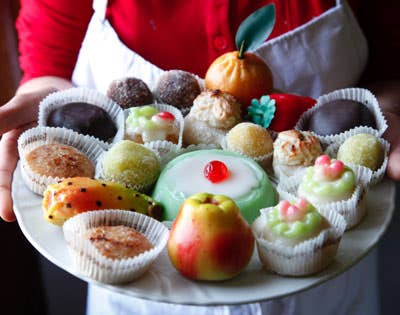
Sicilian Sweets
There were two things I dreamed of doing when I was young: becoming a pastry chef and going to Sicily. My paternal grandmother, Angelina Maggio Malgieri, was from Enna, a town in the center of the island, and when I was growing up in an Italian-American neighborhood in Newark, New Jersey, there were always plenty of cannoli, those crisp-fried pastry tubes filled with luscious ricotta cream, and other Sicilian sweets around. Her stepsister even prepared an altar full of specialties, including elaborately decorated breads, every St. Joseph's day, in honor of the patron saint of Sicily.
By the time I finally visited relatives in Enna in 1974, I had already studied pastry in culinary school. A cousin took me to each and every pasticceria in town and waited patiently as I tried this cannoli, that zeppole di San Giuseppe (fritters filled and topped with ricotta cream, also called sfinci), and anything else that caught my eye. Many were familiar to me in appearance, but the taste of the real thing blew me away: the ricotta was richer, the citrus more perfumed, the almond flavor more intense. It struck me then and there that Sicilian sweets are not just the work of talented pastry chefs; they're the result of hundreds of years of unbroken tradition. I wanted to savor and remember every detail.
That first trip also made me realize just how different Sicilian sweets are from those you find in mainland Italy. Adorned with candied fruit, flavored with nuts, and enriched with sheep's milk ricotta (as compared with the milder cows' milk version), they owe their origins, like lots of other Sicilian foods, to the island's many layers of history, most notably the conquest by Saracen invaders from North Africa. By the end of the tenth century, the Saracens had introduced pistachios, oranges, lemons, and dates, as well as refined sugar and spices such as cinnamon and cloves. They brought the art of preparing elaborate pastries, ices, candied fruit, and almond- and pistachio-based confections. Later, these traditions blended with others; chocolate arrived from Spain during the renaissance, and in the 19th century, Swiss pastry chefs who had migrated to Sicily started blending it with ricotta in desserts. As a result, Sicilians have an astonishing repertoire of sweets, from gelato heaped into a brioscia, or brioche—the bun is a legacy of the French influence on Sicilian food—to thick puddings made with everything from coffee to watermelon juice, to the ricotta-filled cannoli that are beloved around the world.
It wasn't until I returned to research my book Great Italian Desserts (Little, Brown; 1990) that I got to know Sicilian bakers. I went to Noto, a lovely Baroque town just south of Siracusa that has a rich pastry tradition, to meet with Corrado Costanzo, whose family's shop is famed for its jasmine ice, made with mineral water in which flowers, picked at dusk, have steeped overnight. Corrado explained to me the important role convents and monasteries played in the history of Sicilian baking. At the beginning of the 19th century, he said, there were many in the region of Noto alone, and each one was famed for selling a different dolce.
The genesis of some of Sicily's most iconic sweets, like cannoli, is linked to convent bakers. Most historians believe that Saracen invaders brought cannoli to Sicily; another legend says the sweet was invented in the harem of Caltanissetta in central Sicily and brought to convents by a onetime harem member. (The former story is supported by the fact that fried pastries continue to thrive in Andalusia, Spain, from whence some of the conquering soldiers came.)
Not only were the convents bastions of tradition; they were (and are, where they remain) the most authentic source for classic Sicilian sweets. In Palermo, I sampled cannoli made with sheep's milk ricotta at the now shuttered monastery of Sant'Andrea. In Agrigento, I visited the Santo Spirito monastery of cloistered Cistercian nuns, famed for the sweet couscous with crushed pistachios that's made there. But perhaps the most famous baker is Maria Grammatico, whom I visited at her shop in the mountain peak town of Erice. Grammatico's life story has been recounted in the book Bitter Almonds, which she coauthored with Mary Taylor Simeti (William Morrow & Co., 1994). She was raised in an orphanage run by Franciscan sisters, where she helped in the preparation of sweets. Deciding against the nun's life, Grammatico opened a modest pasticceria, which has since grown into one of the largest pastry businesses in Sicily. Grammatico, who is now 70, makes an amazing assortment of traditional cookies and small pastries, but her true talent lies in frutta di Martorana (marzipan fruit, named after the Palermo convent where they originated) shaped from almonds she grinds into a paste daily and paints in realistic colors.
Erice and Noto are two must-visit towns for pastry lovers. Though Corrado Costanzo passed away in 2002, his son, Luigi, and daughter, Giuseppina, continue to run the shop. Today, Noto's superstar pastry chef is Corrado Assenza, whose Caffe Sicilia serves both traditional and modernized versions of Sicilian sweets. The fourth generation of his family to run Caffe Sicilia (it was founded in 1892), Assenza is known for his creative fruit preserves in flavors like bergamot and mulberry. He pipes cannoli with the traditional ricotta filling, but also with dark chocolate and orange and vanilla cream. And you might think that the chile's heat in his orange and wild fennel ice cream is a modern twist, but that's the way his family has always made it.
"Tradition and innovation have had a long history of coexisting in Sicily," he says. Of course, he is right. While the Sicilian desserts I grew up enjoying back in the States are frozen in time, in Sicily they continue to evolve into even more delicious things.
Keep Reading
Continue to Next Story










